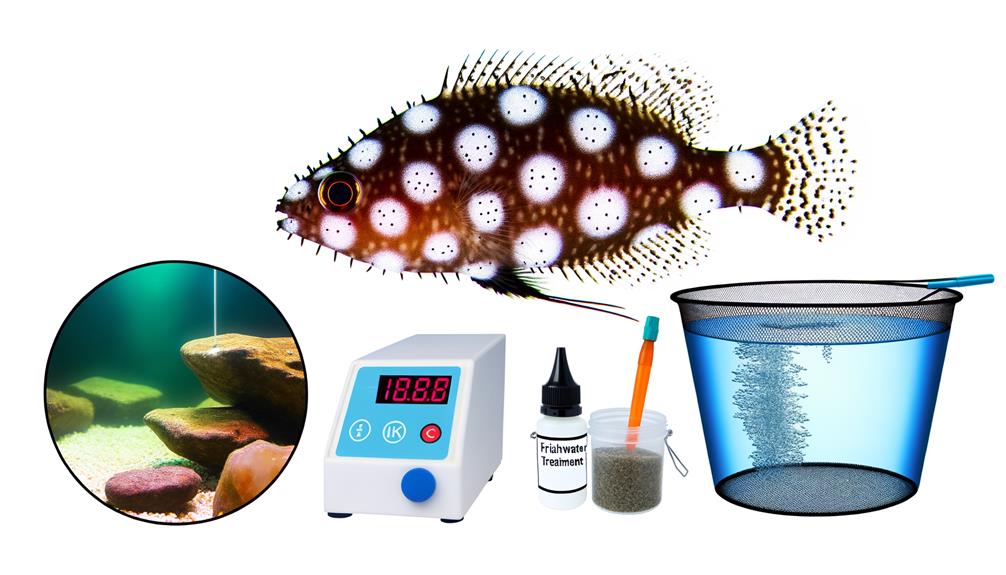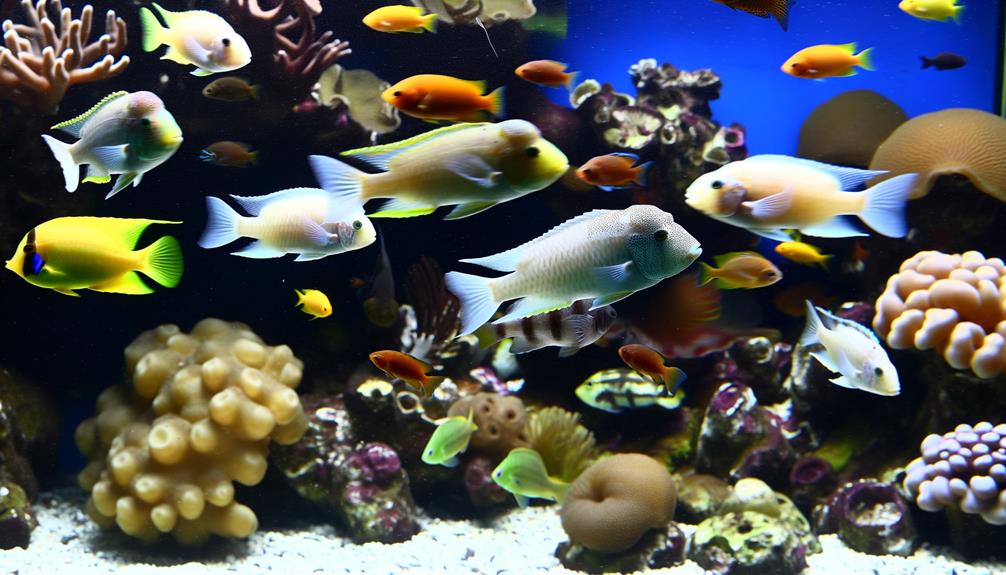In the realm of marine biology, a significant issue that impacts the health of saltwater fish is a parasite-induced condition known as 'ick'. Scientifically labeled as Ichthyophthirius multifiliis, this parasite directly impacts the fish's ability to maintain osmoregulation and respiration.
Symptoms include discoloration, abnormal behavior, and a notable increase in breathing rates. However, the question that arises is, how is this condition effectively treated and what preventative measures can be utilized to mitigate the potential impact on saltwater aquariums?
Key Takeaways
- Yes, saltwater fish can get ick, a parasitic disease caused by Cryptocaryon irritans.
- Symptoms of ick include white spots, behavioral changes, respiratory distress, and changes in appetite.
- Diagnosis typically involves visual observation, water quality monitoring, microscopic examination, and molecular diagnostics.
- Prevention and treatment focus on quarantine procedures, maintaining good water quality, and using copper-based medications.
Understanding Ick: The Basics
Marine ich, colloquially known as ick, is a widespread and highly infectious parasitic disease caused by Cryptocaryon irritans, which presents a significant threat to the health and well-being of saltwater fish populations. This parasite, ubiquitous in the marine environment, manifests itself as tiny white spots on the skin, gills, and fins of saltwater fish.
The life cycle of Cryptocaryon irritans is complex and intimately tied to water temperature. It comprises four stages: trophont, protomont, tomont, and theront. The trophont phase is the feeding stage, where the parasite is attached to the fish. The protomont stage is a dormant phase that ensues after the parasite falls off from the fish. The tomont stage is the reproductive phase that can yield hundreds of new parasites, and the theront phase is when the parasites search for new hosts.
Water temperature significantly influences the duration of these stages. Higher temperatures expedite the parasite's life cycle, causing a faster spread of the disease amongst the population. Thus, understanding and controlling water temperature plays a vital role in managing outbreaks of marine ich.
Meanwhile, preventive measures such as quarantine procedures for new fish and maintaining optimal water quality are pivotal in minimizing the risk of infection.
Identifying Ick Symptoms in Saltwater Fish
How can one identify the telltale symptoms of ich, or marine ich, in saltwater fish? The first and most conspicuous symptom is the appearance of white spots on the fish's skin or fins. These blemishes, often compared to grains of salt, are in essence the visible manifestations of the parasites lodged in the fish's skin.
Along with these dermatological signs, behavioral changes in the fish also provide critical clues. Increased scratching, flashing, or rubbing against objects in the tank are common responses of fish to the irritation caused by the ich parasites. These behaviors are often the fish's attempt to dislodge the parasites.
Moreover, one should also watch for signs of respiratory distress, such as rapid gill movement or labored breathing. These symptoms can be indicative of ich's progression as the parasites can infiltrate the gills, leading to respiratory difficulties.
Other subtle signs can include changes in appetite, lethargy, or abnormal swimming patterns. When multiple fish in the tank simultaneously exhibit these symptoms, it strongly suggests the presence of a marine ich infestation. Prompt identification and action are crucial in mitigating the impact of this disease.
Diagnosis and Treatment Methods

Once the presence of ich symptoms is suspected in saltwater fish, it is essential to proceed with a thorough diagnosis, which can involve several methods, ranging from simple visual observations to more advanced molecular diagnostics. Observing white spots, particularly on the fins and bodies of the fish, is a primary diagnostic marker of saltwater ich. The water quality can significantly influence the number of parasites, thus it should be closely monitored during the diagnosis phase.
If these signs are present, a microscopic examination of skin and gill smears can confirm the presence of ich parasites. Scrapings of skin, fins, or gills can be taken for further analysis to provide a definitive diagnosis. A more advanced and precise method is molecular diagnosis, which identifies specific genes of these parasites.
Upon confirmation of ich, treatment should be administered promptly. The most effective treatments include copper-based medications such as Cupramine®, which require careful monitoring for optimal dosage. It's important to remember that the treatment process requires patience and precision, as dosages must be tailored to the specific needs of each affected fish to ensure their recovery.
Preventative Measures Against Ick
Implementing proactive measures can significantly reduce the risk of ich infection in saltwater fish, thereby ensuring their overall health and longevity. When it comes to prevention, there are several strategies to consider, including maintaining good water quality and proper tank hygiene. These measures help create a robust environment that is less susceptible to ich proliferation.
Consider the following preventative measures:
- Quarantine new fish: Before introducing new fish into the main tank, quarantine them for at least two weeks to prevent the introduction of ich.
- Maintain Good Water Quality: Regularly check and adjust the water parameters to ensure optimal conditions for your fish. Poor water quality can stress fish, making them more susceptible to ich.
- Avoid Fish from Infected Sources: Procure fish only from reliable sources with no known ich outbreaks. An infected fish can introduce the disease into your tank.
- Use Copper Treatment: If your fish show signs of ich infection, hard to see at first, use copper treatment in a separate tank. This can effectively kill the ich parasite.
Impact of Ick on Saltwater Aquariums

In assessing the impact of Ick on saltwater aquariums, it is imperative to understand that the disease can cause significant stress to fish, compromising their immune systems and potentially leading to secondary infections. Infected fish exhibit symptoms like scratching against objects, rapid breathing, and loss of appetite. Furthermore, white spots appear on their skin, signaling the presence of the disease.
The following table illustrates the critical aspects of dealing with Ick in saltwater aquariums:
| Prevention | Treatment | Management | |
|---|---|---|---|
| Focus | Quarantine new fish | Use copper-based remedies or Malachite green | Maintain optimal water conditions |
| Purpose | Minimize risk of infection | Cure infected fish | Create a stress-free environment |
| Benefits | Reduces likelihood of Ick outbreaks | Eliminates Ick parasites | Enhances fish immune systems |
The life cycle of Ichthyophthirius multifiliis in saltwater environments is complex, requiring meticulous management and monitoring of tank conditions. The key to preventing the spread of Ick lies in prompt diagnosis, isolation of infected fish, and treatment with appropriate medications. Thus, maintaining optimal water quality, implementing proper quarantine procedures for new fish, and ensuring a stress-free environment are crucial in reducing the likelihood of Ich outbreaks in saltwater aquariums.
Frequently Asked Questions
Can Saltwater Fish Survive Ich?
Yes, saltwater fish can survive ich through ich resistance development and preventive measures. Maintaining water quality, implementing dietary changes, and applying specific treatments can help eradicate ich, enhancing the fishes' overall health and survival chances.
How Do You Treat Ick on Saltwater Fish?
To treat ick on saltwater fish, utilize copper-based medications like Cupramine®. Monitor the copper levels, maintain between 0.30-0.35 ppm for three weeks. Ick prevention methods and natural ick treatments can also supplement the process.
What Saltwater Fish Are Most Susceptible to Ich?
Tangs and Damsels are most susceptible to Ich due to their size and stress-inducing behavior, respectively. However, fish like Chromis, Clowns, and Gobies show higher immunity, benefiting significantly from proper Ich prevention methods.
What Temperature Kills Ich in Saltwater?
The eradication of Ich parasites in saltwater, a tale of survival, hinges on temperature adjustments. Ich resistance variations decrease around 79-80°F, while temperatures exceeding 86°F can be lethal to both Ich and the host fish.
Conclusion
In conclusion, the parasitic infection ick, caused by Ichthyophthirius multifiliis, poses a significant threat to saltwater fish. Accurate diagnosis based on clinical symptoms, coupled with effective treatment methods, can aid in managing the disease.
Preventative measures, including maintaining optimal water conditions, are crucial in reducing the incidence of ick in saltwater aquariums. Despite concerns about treatment methods, their strategic implementation ensures the health and well-being of saltwater fish populations.


